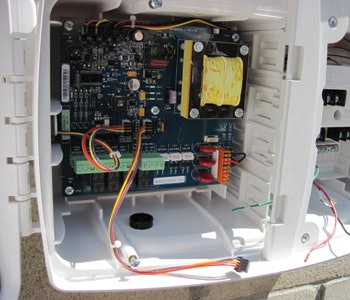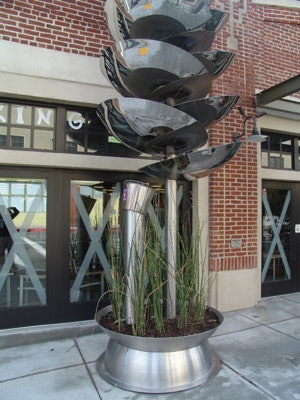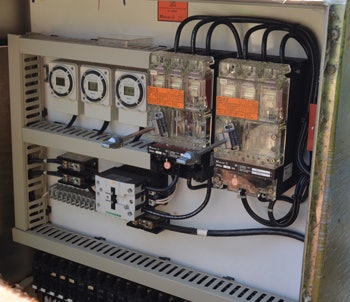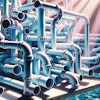
Aquatic designer, landscape architect and educator Mark Holden loves to bend standard technologies to meet his clients’ needs in new ways. In the familiar realm of residential automation and control systems, he’s found a vast spectrum of creative possibility; it is a set of tools, he argues, that can be used to raise the functionality of aquatic design and maximize ease of use and maintenance.
Automation is all about proper delegation. It offers the choice between doing everything yourself or having a system that does it for you. In the aquatics industry that means the homeowner or pool operator doesn’t have to constantly throw switches, move valves, fire up heaters, test water or add chemicals because we have an entire class of products that do those things and more.
This is, of course, nothing new. Automation has been around a long time. The most basic form is the mechanical time clock, a device so simple and reliable that after decades as an equipment pad staple with little change to the design, the time clock remains in widespread use to this day. The reason being, time clocks do exactly what computer-controlled systems do — they open and close relays that activate or deactivate other devices.
Commercial and residential control usually require different approaches. In a commercial pool setting, automation is used largely for utilitarian purposes, turning pumps and heaters on an off, controlling backwash cycles, monitoring and adjusting water chemistry, activating lighting systems, etc. The technology is complex, heavy-duty and typically operated by trained professionals.
In a residential environment, there’s a far more emotional component to it: heating up a spa on demand, turning on landscape lighting to create a mood, activating water features, vanishing-edge systems, fire features or sound systems. Yes, functionality also comes into play, but homeowners love to be wowed emotionally on a daily basis and these days, we have just the toolbox to make it all happen with the touch of a button.
These systems are designed to provide sexy, user-friendly interfaces with touch screens and the ability to control things from personal devices such as smart phones and computer pads.
TO FURTHER USE
Yes, automation is a beautiful thing, but I believe many of us are missing its full potential in how we deploy the technology.
As an example, in my practice, I design and engineer various types of commercial water features in addition to commercial and residential pools and spas. I love working on commercial water features because each one is different and they almost always present some kind of challenge that requires ingenuity and creativity to solve. In reworking existing systems, I find there’s almost always a way to upgrade and overcome existing problems.
On the automation front, I’ve learned volumes about the commercial-grade systems available these days. These products tend to be extremely expensive and require varying levels of training and technical chops to program, operate and service. Most are made with durable materials and rated for long-term, constant use.
There are some truly fantastic systems out there, but they do come with a common set of drawbacks. One of them is that most people running and maintaining these systems are not particularly adept at it. They may be janitors, property managers or superintendents or even pool operators that have all sorts of other responsibilities. When it comes time to reprogram the system or see to its repairs, they inevitably have to call someone and often wait weeks or even months to resolve the problem.
In the meantime, the system is either down or not functioning properly. Depending on the situation that down time can result in lost revenue, compromised consumer satisfaction and frustration. None of those things are good for the way people view their aquatic features and our industry as a whole.
That’s why years ago I started doing this crazy thing where I engineered these systems using residential equipment and construction techniques. Instead of using one five-horsepower variable-speed drive pump to do everything, I might use four or five residential one-horsepower power units instead with things set up in sequence or in parallel.
For starters, this approach keeps the initial price of the system down, but it also builds in redundancy. If one pump goes down, you still have a series of others continuing to operate. It also means greater availability of service people to work on these systems, and parts are also cheaper and much easier to come by.
By contrast, with a single pump doing all the work, if the system goes down completely, there are only a handful of people who know how to do repairs, and parts delivery takes a long time.
There certainly are some extreme applications where commercial systems are called for, but in most cases, I’ve found that the residential products are a superior choice.

FLEXIBLE EASE
I apply the same strategy when it comes to automation and controls. Rather than using commercial systems, I’ll turn to the Zodiac/Jandy Aqualink or Hayward Pro Logic systems. These systems do the same exact thing as commercial-grade systems in terms of activating a solenoid, controlling valve actuators and monitoring ORP and pH, but they are far easier to use and much less expensive.
The convenience and ease-of-use factor alone is, in my mind, reason enough to go in this direction. Consider what’s happened with consumer computer technology over just the past five years. There was a time when setting up a home computer system involved entering codes, installing software, configuring hardware drivers, etc. Especially in the PC world, you always had to open up a manual and figure things out.
Nowadays, computers are basically plug and play. As users, we are asked to perform far fewer tasks. Simple menu-driven screens and logical system navigation have made it so that someone with virtually no technical experience or aptitude can sit down and easily use a computer.
The same exact thing has happened with residential swimming pool and spa controls. In the real world that means organizations have a far easier time finding employees who can operate their systems. And when they do run into trouble, help is readily available online or just down the street at a local service company.
On top of that, these systems come with default settings that make things even easier. We know, for example, that in a vast majority of situations, the desired pH range will be between 7.2 and 7.4. These systems are preset to that range and you don’t have to do anything in the initial set up. Taking it a step further, today’s systems are controllable via smart phones or computer tablets. If the pH or sanitizer levels get out of whack or a pump goes down, the system will send you an email or text letting you know there’s an issue.
Now, you have a system that is easy to use, easy to fix and will tell you immediately when you have a problem. All of those advantages make this type of system the equal of commercial systems, but far more manageable and reliable. If you misplace the manual, you can download it online and in most urban areas, you can find multiple service technicians that work with these systems on a regular basis.
To my mind, there’s absolutely no reason that commercial clients shouldn’t enjoy the same conveniences as their residential counterparts. It’s really just common sense.
FORMS AND FUNCTIONS
All of those advantages make for a great story to share with potential clients as well as other project team members, be they general contractors, architects, landscape architects, consulting engineers, etc. It’s an approach I’ve found works across a wide range of applications and types of projects.
(Plus, we live in a time when there are virtually no codes or standards that prohibit using residential automation in commercial settings. Frankly, I’ve been pleasantly surprised by how little resistance I’ve encountered re-appropriating technology in this way.)
On one level, you have very simple fountain features where you might be controlling a small number of elements: perhaps a single waterfall or a small number of vertical plumes along with a simple lighting system and basic chemical control. In many respects, those systems are very similar in terms of complexity to a residential swimming pool. After all, actuating a valve or activating a pump to turn on a vanishing edge system in a backyard is really no different than a sheeting waterfall on an entryway feature at a resort or condominium complex.
Things become far more interesting when dealing with more complex systems. For example, I’m currently engineering a large commercial decorative feature that will include 100 laminar jets from Zodiac/Jandy with LED lights, all controlled with an Aqualink system. (In fact, the entire system will use residential equipment.)
In this situation, I’ll be able to create various operation scenarios that will vary the scene, simply by controlling the flow to the laminar jets and their LEDs. We won’t be able to achieve some of the more advanced choreography that you’d find with some massively expensive and complex commercial fountain systems, but this feature will use a “poor man’s approach” to achieve a variety of different looks to suit the client’s different needs.
Some might argue, why not go with a system that’s specifically designed for that type of application? Good question. The first answer is quite simply that if we tried to go that route, the client wouldn’t be able to afford the system. In fact, in this case, running the numbers, it’s not even close. So, in the real world of dollars and cents, this system wouldn’t even exist if it weren’t for the capabilities of the residential control system.
In effect, the technology we’re using is making possible a spectacular system that not only wouldn’t otherwise exist, it’s also going to be easy to use and serviceable.
For many, including the manufacturers themselves, it can be quite surprising what you can achieve without really bending the technology too much from its original intent. As another example, I’ve created interactive leaping jet features using residential controls to operate three-port valve actuators and change operation settings on variable-speed drive pumps. Granted, those systems do require greater-than-usual ingenuity because you’re controlling hundreds of different actions, but when you break it down, action-by-action, the function is essentially the same.

OFF-BEAT USE
The other huge aspect of this approach unfolds when you get into more-unusual applications. In most cases, you’re still using the system to change valve positions, turn power on and off to solenoids and throw relays. The difference is what you’re controlling.
I recently worked on a lovely decorative system at a Whole Foods in Pasadena, Calif. In this case, the owners wanted to use condensation from the building’s cooling tower in a sculptural feature where water fills and overflows a series of bowls, creating a sort of vertical water chain at the store’s entrance.
After the water flows through feature, they also wanted to use it to irrigate nearby plantings. The problem was that the plants didn’t need nearly the water volume that was flowing through the system. (It’s amazing how much condensate cooling towers can generate.)
Using a simple Rain Bird irrigation controller, we controlled a Zodiac/Jandy Neverlube three-way valve with a JVA motorized actuator that would direct the excess water to a storm drain. Now, we have a system where wastewater is used in a sculptural feature and also to water plants in an environment prone to drought.
These days, my portfolio is chock full of projects where residential control systems are used for all sorts of functions. That list includes landscape lighting as well as video security systems, gate and door locks, misting systems, fire features and outdoor sound systems, among others. In all cases, we’re able to establish a range of operating scenarios across a range of functions.
ALL TOGETHER
When you add it up and think just slightly differently about ways this technology can be applied, we’re really only limited by imagination. Sure, you can be satisfied to make a spa heat up or turn on the lights in the pool, and there are always going to be clients who want little else, but those functions barely scratch the surface of what you can do.
And here’s where I do call out manufacturers for a lack of vision. On one hand, these companies, the two I’ve mentioned here and others as well, have done a fantastic job creating systems that are versatile and easy to use. I’d go so far to say that in that sense, automation in general is one of the great success stories we can share with clients.
On the other hand, manufacturers have been extremely limited in how they promote the different things their products can do. I’d love to be proven wrong on this front, but as one who pays close attention to this part of the aquatics professional market, I see suppliers who seem almost afraid to suggest uses that are just a step or two outside the norm.
That relatively minor frustration simply means that we have more work to do in defining applications and figuring out ways to best apply the tools we have. Put another way, I’ve seen some pretty creative uses of mechanical time clocks over the years, and there’s no reason that today’s aquatic designers and engineers can’t view residential control and automation systems in a similarly inventive way.
After all, when you can turn things on and off with ease, there are almost no limits to what you can achieve.
Comments or thoughts on this article? Please e-mail [email protected].







































